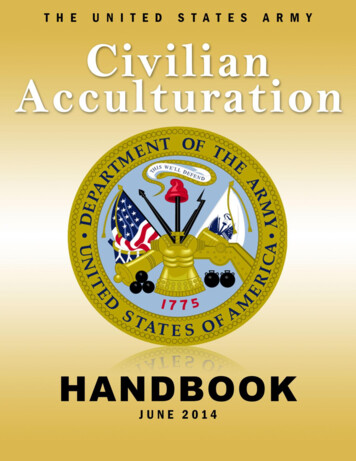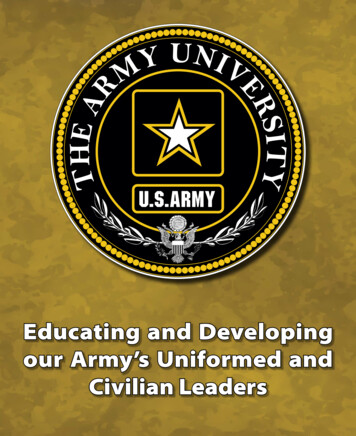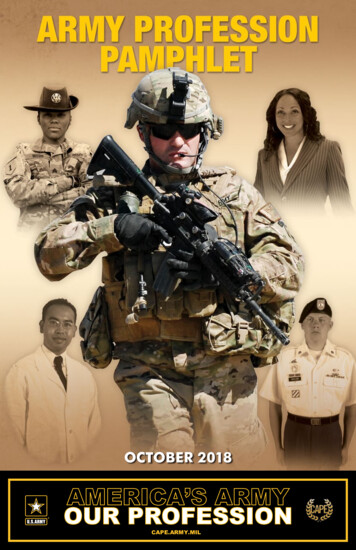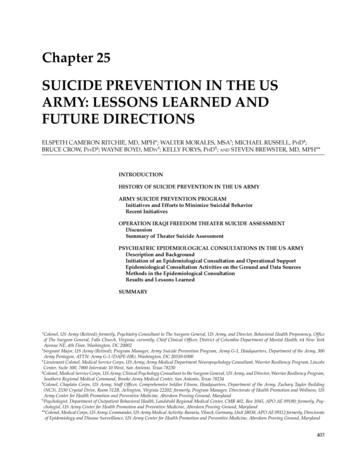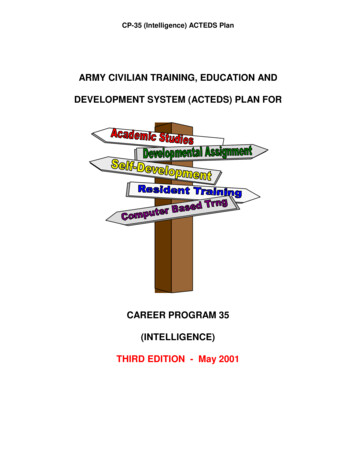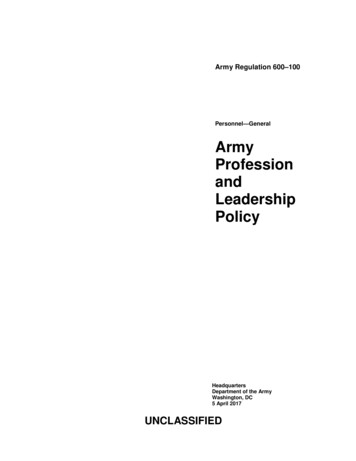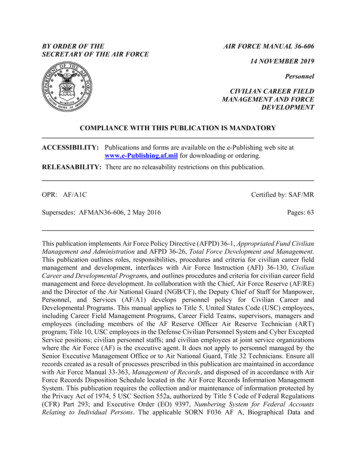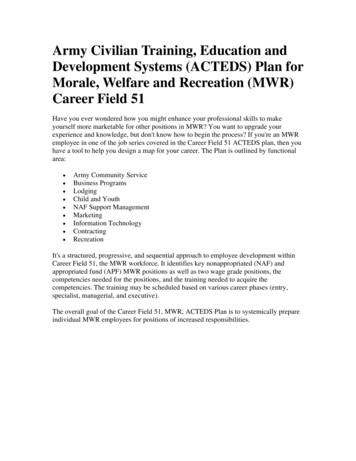
Transcription
Army Civilian Training, Education andDevelopment Systems (ACTEDS) Plan forMorale, Welfare and Recreation (MWR)Career Field 51Have you ever wondered how you might enhance your professional skills to makeyourself more marketable for other positions in MWR? You want to upgrade yourexperience and knowledge, but don't know how to begin the process? If you're an MWRemployee in one of the job series covered in the Career Field 51 ACTEDS plan, then youhave a tool to help you design a map for your career. The Plan is outlined by functionalarea: Army Community ServiceBusiness ProgramsLodgingChild and YouthNAF Support ManagementMarketingInformation TechnologyContractingRecreationIt's a structured, progressive, and sequential approach to employee development withinCareer Field 51, the MWR workforce. It identifies key nonappropriated (NAF) andappropriated fund (APF) MWR positions as well as two wage grade positions, thecompetencies needed for the positions, and the training needed to acquire thecompetencies. The training may be scheduled based on various career phases (entry,specialist, managerial, and executive).The overall goal of the Career Field 51, MWR, ACTEDS Plan is to systemically prepareindividual MWR employees for positions of increased responsibilities.
Army Civilian Training, Education and DevelopmentSystems (ACTEDS)Plan for Family and Morale, Welfare and Recreation(FMWR) Career Field 5123 April 2008
Army Civilian Training, Education and Development Systems (ACTEDS)Plan for Family and Morale, Welfare and Recreation (FMWR) Career Field 51TABLE OF CONTENTSIntroductionpage 1Scope and Applicabilitypage 1Table of Job Series/Specialty/Titlepage 2Goalpage 6Outcomespage 6Career Progressionpage 6Structure of the FMWR ACTEDS planpage 8Master Training Planpage 10FMWR Competency Modelpage 11Training Sourcespage 14Universal Training Prioritiespage 16Individual Development Plan Purposepage 18Sample Individual Development Planpage 19ACTEDS Career Ladders and Curriculum:Army Community Servicepage 20Business Programspage 33Lodgingpage 48Child and Youthpage 69NAF Support Managementpage 84Financial Managementpage 85Marketingpage 90Information Technologypage 101Contractingpage 103i
Recreationpage 121Appendix A:CF-51 Career Development Guidepage 185ii
ACTEDS (CF-51)WELCOME FAMILY AND MORALE, WELFARE AND RECREATION CAREER FIELD - (CF-51)PROFESSIONALSSUBJECT:Army Civilian Training, Education and Development Systems (ACTEDS)Plan for Career Field 51 Morale, Welfare and Recreation (MWR) (CF-51)This ACTEDS revision fully integrates the Army Leader-Development model for civilians; embraces the Army FMWRvision; and incorporates the Strategic Plan into a continuous, dynamic system of learning and growth. This plan is acomprehensive, sequenced plan of training, education and professional development experiences required for your careerprogression. Resting on a foundation of core technical competency, this plan integrates leadership skills and businessbased competencies to lead a flexible and responsive Army FMWR Team into the 21st Century.Professional growth and self-development is the joint responsibility of the employee and supervisor. This ACTEDS Planprovides a roadmap to career progression. We charge each supervisor and FMWR leader to support this ACTEDS Planand make career development and professionalism a reality for the Army FMWR employees.IntroductionThe ACTEDS Plan documents a structured, progressive, and sequential approach to employeedevelopment within Career Field 51 (Family and Morale, Welfare, and Recreation [FMWR], ArmyCommunity Service and Army Lodging). The FMWR ACTEDS Plan is a competency-based, careerprogression "road map" that blends training and self-development to systematically enhanceindividual performance and potential.Scope and ApplicabilityThis ACTEDS Plan is intended for the General Schedule, Wage Grade, and Nonappropriated Fundemployees who work within the FMWR CF 51. Principal among these are the specialty, job series,and FMWR position title identified in the Table below. Under the Department of ArmyNonappropriated Fund Pay Band System, FMWR position titles may vary from those listed.The Plan identifies training and development needed to sustain and improve the ability of the FMWRworkforce to successfully execute its diverse responsibilities. The plan provides a path by which tofurther develop competencies through experience, education, training, and personal career planning.The overall goal of the FMWR ACTEDS Plan is to prepare the individual FMWR employeesystematically for positions of increased responsibility. The following table is not inclusive; it lists thetitles on the career ladders by job series. For additional information on all CF-51 series, specialty andposition titles see AR 600-3.1
JobSeriesSpecialty0030Recreation0101Social ScienceProgramSpecialist0102Social Aide &Technician(MWR)Social ScienceWorker (MWR)0185018601870188Social ServicesAid andAssistantSocial Service(Dual proponentwith ion Aid& Assistant0301MiscellaneousFMWR Position Title (varies with location)SPORTS FITNESS, AQUATICS & ATHLETICS SUPVFACILITY MANAGERATHLETICS/INTRAMURALS PROGRAM MANAGERCERTIFIED FITNESS INSTRUCTORFITNESS & HEALTH SUPVINDOOR FACILITY MANAGEROUTDOOR FACILITY MANAGERAQUATICS MANAGERHEAD LIFE GUARD/ASST MGR NAFFITNESS SPECASSISTANT AQUATICS MANAGERLIFEGUARDCHILD AND YOUTH SERVICES SPORTS & FITNESS PROGRAM MANAGERCHILD AND YOUTH SERVICES SPORTS & FITNESS DIRECTORARMY COMMUNTIY SERVICE DIRECTORRELOCATION READINESS MANAGERFAMILY SUPPORT COORDINATOR (FAMILY READINESS)EMPLOYMENT READINESS PROGRAM MANAGEREXCEPTIONAL FAMILY MEMBER PROGRAM MANAGEROUTREACH PROGRAM COORDINATORFAMILY ADVOCACY PROGRAM VICTIM ADVOCATEFAMILY ADVOCACY PROGRAM VICTIM ADVOCATE COORDINATORFAMILY ADVOCACY PROGRAM EDUCATION SPECIALISTFINANCIAL READINESS PROGRAM MANAGERFAMILY ADVOCACY PROGRAM MANAGERNEW PARENT SUPPORT PROGRAM SOCIAL WORKERVICTIM ADVOCATE LEAD SOCIAL WORKERSOCIAL SERVICE REPRESENTATIVE (AFAP/AFTB)Shared dual proponency with U.S. Surgeon GeneralSOCIAL SERVICE REPRESENTATIVE (I&R)ARMY EMERGENCY RELIEF PROGRAM MANAGEROUTDOOR RECREATION SUPVRECREATION CENTER SUPVRECREATION SPECIALISTOUTDOOR RECREATION SPECIALISTLEAD RECREATION ASSISTANTRECREATION ASSISTANTADMINISTRATIVE MANAGEMENT SPECIALIST2
0343Management ntFinancial MgtBudget AnalystBudgetAssistantGeneral Artsand Information(MWR)MarketingMusic SpecialistTheatreSpecialistArt SpecialistGeneralBusiness &Industry (MWR)ARMY VOLUNTEER CORPS COORDINATORAUTOMOTIVE CRAFTS FACILITY MANAGERDIRECTOR OF COMMUNITY RECREATIONARMY COMMUNITY SERVICE VOLUNTEER COORDINATORRECREATION PROGRAMER SUPVRECREATION PROGRAMERFACILITY MANAGER SUPVMOBILIZATION & DEPLOYMENT SPECIALISTSPECIAL EVENTS COORDINATORPROGRAM SUPPORT ASSISTANTHOTEL FRONT OFFICE MANAGERHOTEL/LODGING TRAINING SPECIALISTHOTEL RESERVATION MANAGERPROGRAM REGIONAL MANAGERDMWRMANAGEMENT ANALYSTPROGRAM ANALYSTSUPERVISORY PROGRAM ANALYSTCHIEF FINANCIAL MANAGEMENTFINANCIAL MANAGEMENT OFFICERFINANCIAL MANAGEMENT SPECIALISTCHIEF FINANCIAL MANAGEMENT OFFICER/FINANCIAL ADMINFINANCIAL MANAGEMENTHOTEL COMPTROLLERHOTEL ACCOUNTING TECHNICIANBUDGET ANALYST /FINANCIAL ANALYSTBUDGET ASSISTANTARTS INFORMATION SPECIALISTENTERTAINMENT SUPVSOLDIER ENTERTAINMENT MANAGERENTERTAINMENT TECHNOLOGY SPECIALIST (AUDIO AND LIGHTING)CHIEF ARMY ENTERTAINMENTGRAPHIC ARTIST/ILLUSTRATORMUSIC SPECIALISTTHEATRE SPECIALISTART SPECIALISTSUPERVISORY ART SPECIALISTARTS AND CRAFTS PROGRAM MANAGERARTS AND AUTO CRAFTS SUPERVISORAUTO SPECIALISTBUSINESS OPERATIONS DIRECTORBOWLING (MULTIPLE CENTERS)3
11021105Contracting dging1410LIBRARIAN1411LIBRARY TECH1601Management1701Child & YouthServices1160BOWLING MANAGER (OVER 13 LANES)BOWLING MANAGER (12 LANES OR LESS)GOLF GENERAL MANAGERASSISTANT GOLF MANAGERDIRECTOR OF GOLFGOLF PROFESSIONALFOOD AND BEVERAGE DIRECTOR (CLUBS)FACILITY MANAGER (CLUBS)ASSISTANT FACILITY MANAGERCHEF/CATERERASSISTANT FOOD AND BEVERAGE DIRECTORMARKETING DIRECTOR/SUPERVISORY MARKETING SPECIALISTMARKETING SPECIALIST ACCOUNT EXECUTIVEMARKETING RESEARCH SPECIALISTCOMMERCIAL SPONSORSHIP ADVERTISING SPECIALISTSUPERVISORY CONTRACT SPECIALISTSUPERVISORY PROCUREMENT ANALYSTSENIOR PROCUREMENT ANALYSTSENIOR CONTRACT ADMINISTRATORSENIOR CONTRACT SPECIALIST (TEAM LEADER)SENIOR CONTRACT SPECIALISTCONTRACT SPECIALISTCONTRACT SYSTEMS ADMINPROCUREMENT ANALYSTCONTRACT SPECIALISTPURCHASING AGENTFINANCIAL ANALYSTLODGING MANAGERASSISTANT LODGING MANAGERREGIONAL LODGING PROGRAM MANAGER(Dual proponency with CP 34)LIBRARIAN(Dual proponency with CP 34)LIBRARY TECHEXECUTIVE HOUSEKEEPERASSISTANT EXECUTIVE HOUSEKEEPERFACILITIES MAINTENANCE SUPERINTENDENTGREENS MANAGER (GOLF)GOLF COURSE SUPERINTENDENTCHILD AND YOUTH SERVICES (CYS) COORDINATORCDS ADMINISTRATORYS ADMINISTRATORCLEOS ADMINISTRATORCHILD DEVELOPMENT CENTER DIRECTORFAMILY CHILD CARE DIRECTORTRAINING AND CURRICULUM SPECIALISTCDC SATELITE SITE DIRECTOR4
ASSISTANT CDC DIRECTORSCHOOL AGE SERVICES FACILITY DIRECTORTRAINING & PROGRAMMING SPECIALISTSAS SATELITE SITE DIRECTORSAS PROGRAM DIRECTORASSISTANT SAS DIRECTORYOUTH FACILITY DIRECTORYOUTH SATELITE SITE DIRECTORTRAINING & PROGRAMMING SPECIALISTYOUTH PROGRAM DIRECTORASSISTANT YOUTH DIRECTORCY LIAISON EDUCATION AND OUTREACH SERVICES DIRECTOR (CLEOS)OUTREACH SERVICES DIRECTORSCHOOL LIAISON OFFICERYOUTH EDUCATION SUPPORT SERVICES SPECIALISTYOUTH EDUCATION LIAISON OFFICER170217101712221048197405Education TechnologyWG/NAWG/NAShared dual proponency with TRADDOCAUTOMOTIVE SKILLS INSTRUCTORMWR ACADEMY INSTRUCTORINFORMATION TECHNOLOGY SPECIALIST (NETWORK)INFORMATION TECHNOLOGY SPECIALIST (POLICY AND PLANNING)Bowling Equipment RepairingBartending5
Goal:The overall developmental goal of the FMWR ACTEDS Plan is to provide employees and theirsupervisors with a reference to assist in determining appropriate training to enhance on-the-jobperformance and to prepare the employee for progressively more responsible positions.Short-Term Desired Outcomes1. To assist supervisors and employees in determining training offered.2. To maximize employee job proficiency and quality of service.3. To provide employees and their supervisors with a reference to assist in determining appropriatetraining to enhance on-the-job performance and to prepare the employee for progressively moreresponsible positions.Long-Term Desired Outcomes1. To enable employees to plan and sequence appropriate career training and development.2. To acquire competencies through training and self-directed development listed in career ladders forcareer growth.3. To develop and strengthen employee professional qualifications and leadership abilities inpreparation for assuming progressively more responsible positions within the FMWR career field.4. To develop and strengthen employee professional qualifications and leadership abilities inpreparation for executive positions within CF-29 (Deputy Garrison Commander, etc.).ExperienceExperience is the concrete application of education and training to specific situations to accomplishorganizational tasks. It validates the training and enhances the knowledge acquired. Experience ischaracterized by action, by doing. It reinforces, explicitly and practically, what one has learnedintellectually. Thus, experience reinforces learning and also validates the learning process.Experience is indispensable to career progression. Resting on a solid educational base, training andexperience are inextricably linked. At the beginning of career progression, training to do the work is ofgreater importance than experience. Over the course of career progression, experience, whichreinforces training and revalidates education, becomes more important to competency and careerprogression.Career ProgressionThe size and occupational diversity of the FMWR workforce dictate a broad-based ACTEDSstructure. The FMWR career field encompasses various functional areas and series based on thepreceding Table, each highly specialized and requiring a great deal of technical knowledge.Numerous occupational series are represented in each of their functional specialties.There is no rigidly structured system by which an employee progresses from entry level, throughspecialist levels, to management level and executive/senior executive level career positions. Thescope and diversity of the FMWR "umbrella" make it unrealistic, if not virtually impossible, to design acareer ladder depicting professional growth across an expansive employee population, numerousoccupational specialties, many job series, and two distinct civilian personnel systems.6
The generic FMWR career ladder at Figure 1 outlines potential progression patterns for horizontal,vertical, and diagonal career movement. The type of move that is appropriate for any given individualwill depend on that employee's particular educational background, job experience, training,developmental assignments, and the requirements of the target position. Employees are encouragedto gain the broadest possible range of functional and command experience, and to seek promotionsto other MWR specialties when they possess the appropriate qualifications. Career growth dependsto a great extent on personal mobility, leadership training, FMWR job-specific training, selfdevelopment efforts, on-the-job-training in developmental assignments, and employee performance.Career Field 51 (FMWR) ACTEDS Plan provides career development paths, including competencies.Career Field 51 is the primary functional proponent for training for Wage Grade and Craft and Tradepositions (WG/NA Bartender - 7405 and WG/NA Bowling Equipment Repairer - 4819). Careeradvancement paths, Knowledge Skills and Abilities (KSA’s), etc., for FMWR Wage Grade, and Craftand Trade positions in other job series can be found in ACTEDS Plans developed by the primaryfunctional proponent for those job series (listed in AR 600-3, The Army Personnel Proponent System,available at servicing Civilian Personnel Offices or online). Individuals in clerical and administrativepositions interested in career development into one of the FMWR key positions are encouraged toreview the competencies and training requirements for entrance and advancement for that specificjob series listed in the ACTEDS Plan developed by the primary functional proponent. There are jobseries listed in the (FMWR) ACTEDS Plan for which Career Field 51 is "not" the primary functionalproponent. These job series are also covered in one of the other career programs/fields ACTEDSPlans, but have additional MWR-specific competencies and training requirements. For information onpreparing your resume and use of the automated resume database, see Appendix B.7
FIGURE 1Career Field 51Family and Morale, Welfare, and RecreationGeneric Career LadderGradeInstallationIMCOM RegionIMCOM HDQ/ DAFMWRCSenior NF 5GS 13-15DFMWR(Director Family andMorale, Welfare &Recreation)Division ChiefFMWR ChiefFMWR ChiefSenior ExecutiveDivision ChiefBranch ChiefBranch ChiefProgram ManagerProgram ManagerProgram SpecialistDivision ChiefBranch ChiefBranch ChiefProgram ManagerProgram ManagerProgram SpecialistNF 5GS 13-14NF 4-5GS 12-13NF 4GS 11-12NF 3-4GS 7-11NF 3GS 5-7Clerical & AdminWage Grade Craft &TradeDivision ChiefProgram ManagerBranch ChiefActivity ManagerProgram ManagerProgram ManagerProgram SpecialistEntry/InternTraineeNOTE: This Generic Career Ladder is intended to allow for horizontal, vertical and diagonalmovement among levels at all grades. Grades are subject to the scope of responsibilities of theposition and may vary among installations.Although this ladder only shows positions at the Senior NF-5 (GS-13-15 equivalent) as DFMWR orFMWR Chief the possibility of advancing to other career fields is available to FMWR employees suchas CF 29 (Deputy Garrison Commanders, etc).A Career Ladder for each functional area is included in this ACTEDS guide.Structure of the MWR ACTEDS PlanIn accordance with the purpose of ACTEDS, FMWR career advancement may be defined in terms offour levels of developmental progression. At each level, planned training, "build-on" or developmentalassignments, and self-development are essential to quality job performance and creating the potentialfor advancement. The four MWR developmental levels are (1) Entry/Management Trainee, (2)Specialist, (3) Managerial, (4) Executive and Senior Executive.8
Entry LevelAt least initially, the entry level (GS 5-7 or NF 3) marks a stage whose central activity is learning anddeveloping leadership skills. It follows that the greatest concentration of mandatory training occurs atthis level, wherein basic competencies needed for successful job performance are acquired.Specialist LevelEmployees at this level (GS 9-12 or NF 4) receive training to build on and enhance their technicalabilities. Courses contained in the FMWR Master Training Plan reflect this emphasis. Developmentalassignments to other FMWR functional areas are encouraged for those who aspire to key positionsrequiring breadth of experience across several MWR functions. Developmental assignments aredesigned toa. Blend with training courses and other experiences (e.g., formal education) to form a sequential andprogressive development plan.b. Enhance staffing flexibility by strengthening the experience of employees to prepare them formanagerial responsibilities.c. Increase the proficiency of high potential personnel by providing the opportunity to (1) acquireadditional competencies required by their occupational specialty; (2) obtain needed competencies inother related lines of work; or (3) prepare for managerial or executive responsibilities.d. Broaden employees' perspectives by providing an understanding of operations in related functionsor in other FMWR functional areas.Managerial LevelEmployees at the GS 12-13, or NF 4-5 level should concentrate on improving or enhancinginterpersonal skills as well as managerial, leadership and conceptual abilities. At this stage, selfdevelopment activities are strongly stressed, as is continued use of developmental assignments.Executive and Senior Executive LevelAt this level (GS 13-15 or NF 5-6), employees are expected to have in-depth knowledge of all aspectsof FMWR operations, leadership and management. Managers are expected to sharpen insights intothe dynamics of human and organizational behavior and to improve skills and personalunderstandings that increase work place effectiveness.Developmental Assignmentsa. Developmental assignments are powerful tools for personal and professional development. Adevelopmental assignment can improve competencies, leadership skills, self-awareness, morale andorganizational performance. Developmental assignments also promote learning, career planning, jobenrichment, and career progression. Further, it is an effective way to tap into the valuable resource ofhigh potential employees and instill a culture of assisting and developing less experiencedemployees.b. Supervisors are valuable resources for assessing an employee’s current skills and recommendingdevelopmental opportunities (i.e., details, temporary promotions, reassignments, etc.) that may helpmeet the employee and organization’s current and future needs.c. Developmental assignments may or may not require a TDY to another location and aredocumented on NAF personnel actions.9
Master Training Plan (MTP)1. The Master Training Plan (MTP) is a vital tool in career progression. The MTP provides thefollowing five functions: (1) identifies the certification requirements in terms of education, training andexperience; (2) incorporates the Army Leader-Development training into a coherent, integrated careerpath; (3) integrates executive training, assignment-specific training, and cross-training in support ofthe MWR mission; (4) identifies self-development activities and desired education at various stages ofcareer development; and (5) provides a framework and guide for the development of the IDP. Thefollowing chapters provide a MTP for each functional area.2. The MTP sets forth the career progression within CF-51 in a logical, sequential, building blockmanner.a. At the entry-level within each career field, the initial focus is on the technical training,reinforced by the assignments and specific experience required to acquire proficiency (markedby Level I certification) in that career field. Some positions have requirements for assignmentspecific courses that may be required before assuming the position or, in some cases, shortlyafter assignment to the position.b. The same pattern continues at Level II. The careerist who is certified at Level II nextconcentrates on courses at Level III. This would be supplemented by cross-training /developmental assignments / rotations in these career fields.3. ACTEDS is a competency based system, and the MTP provides the employee with a career path,plan of education, training, and experience to acquire the competencies supporting careerprogression in CF-51. In each functional area we provide the technical competencies associated withthe occupational series. The FMWR Competency Model is used by employees, supervisors, andmanagers to ensure that individuals have the skills necessary to perform satisfactorily at a givenlevel. The competencies are organized in a logical, sequential, and building block fashion. Initial basiclevel competencies establish fundamental qualifications and expertise in the career field, with acombination of specialization and broadening of skills in the competencies required at Levels II andIII.Figure 2-Leadership-Technical Skills Framework10
FMWR Competency ModelThe following competencies are those required for professional excellenceCompetency DefinitionA competency is a characteristic and measurable pattern of knowledge, skills, and behaviors, whichunderlie and drive superior performance on the job.Core CompetenciesLeading PeopleChange and Continuous ImprovementBusiness and Technical ProficiencyCommunicationDrive for ResultsCompetency DefinitionsLeading PeopleDrives shared vision, values and goals. Influences people so that they will willingly follow.Leadership: Translates vision into action and influences others to accomplish the mission.Teambuilding/Teamwork: Promotes collaborative approaches to opportunities, issues and problems.Conflict Management: Manages and resolves conflicts and disagreements in a positive andconstructive manner.Enabling and Developing Others: Provides the means, knowledge, empowerment and/or opportunityto create an environment that supports professional growth.Interpersonal Skills: Considers and responds appropriately to the needs, feelings, capabilities, andinterests of others.Leveraging Diversity: Recognizes, respects, and taps the abilities of diverse individuals and groups.Change and Continuous ImprovementImprove processes, products, programs, performance, and services.Continual Learning: Promotes an environment that values and seeks training, feedback, andopportunities for development of self and others.External Awareness: Stays informed of organizational operating guidelines, trends, special interests,other issues; and considers impact on the organization.11
Flexibility: Adapts and responds quickly to changes in the workplace environment.Resilience: Maintains focus under pressure.Strategic Thinking: Formulates long-term strategies consistent with the organization’s mission.Creativity/Innovation: Develops new insights and applies innovative solutions to make organizationalimprovements.Leading and Managing Change: Guides organizational changes in a planned and systematic fashion.Business and Technical ProficiencyAppropriately applies best practices to meet organizational goals and mission requirements.Technology Management: Seeks information about and applies new technology to meetorganizational needs.Functional Proficiency: Demonstrates operational proficiency in current occupational series.Resource Management: Applies principles of financial, personnel, and/or material management.Organizational Awareness: Exhibits understanding of the structure of the organization its relationshipto the individual’s position and the larger system.12
CommunicationExchanges ideas, messages, and informationOral Communication: Expresses facts and ideas clearly in conversations and interactions, andactively listens to others. Establishes and/or participates in open exchanges of ideas, information andknowledge.Written Communication: Expresses facts and ideas in writing in a clear, concise and organizedmanner.Influence and Negotiation: Persuades persons or events, builds consensus, and gains cooperationfrom others.Drive for ResultsDirects processes to accomplish desired outcomesCustomer Service: Anticipates and focuses on the needs of customers.Accountability: Holds self and/or those supervised responsible for meeting obligations.Decision making/problem solving: Identifies and analyzes problems and recommends solutions.Makes sound, well-informed decisions.13
Training SourcesThe development of competent leaders is one of the Army's stated and fundamental imperatives. Itsdriving principle is that leaders must be appropriately prepared for increasingly responsible positions.This mandate is accomplished through a combination of schooling, assignments, and selfdevelopment.The Army ACTEDS training catalog is published each fiscal year and is available at the civilianpersonnel online web site http://www.cpol.army.mil . The Training Catalog describes both the Army’sCivilian Leader Development Core Curriculum and the courses associated with it; describes eachSenior Service College Program; provides details of Army Career Program Functional ChiefRepresentatives’ Competitive Professional Development Programs and describes other governmentand non-government courses. The catalog provides a calendar of professional and long-term trainingopportunities each fiscal year and a number of Online forms for course registrations.Another source of training can be found at http://www.army.mil/ako/. Numerous e-learning coursesare offered. SkillSoft is an international producer and distributor of interactive server-based trainingsolutions. The company offers thousands of hours of programming covering application development,system administration, office systems, business skills, interpersonal skills, environmental, safety andhealth topics, etc. This system also hosts the Rosetta Stone foreign language content provided byFairfield Technologies.The Army Civilian Education System consists of progressive and sequential development of civilianleaders who, through training, will possess the proficiency and confidence to accomplish their soldiersupport mission. These courses are available through the Army Management Staff College. Forcourses through the Army Civilian Education System, you can enroll onlinehttp://www.amsc.belvoir.army.mil. These courses require both student and supervisor participationand approval. Courses are distributive learning and resident courses and enrollment information maybe found at the web site.Complementing the Army-wide training, within the MWR career field, a strong institutional trainingfoundation has been established. It rests on courses developed and delivered by the Family andMorale, Welfare, and Recreation (FMWRC) MWR Academy. The MWR Master Training Concept, inconjunction with the ACTEDS for CF51 forms the basis of the MWR Academy’s curriculum.Together, these guidelines provide a structured, progressive, and sequential approach to MWRemployee development and training for entry-level through executive-management positions. TheMWR Academy is a full-fledged brick and mortar institution of professional learning and careerdevelopment. Over 50 courses and training programs are provided both at the Academy and viaweb-based training. Most of the courses are recommended for award of college credit; all coursesqualify for Continuing Education Units (CEU’s). Enrollment in these courses is accomplished on lineat www.mwraonline.com at this website; the MWR Academy also supports employee performancethrough a variety of methods including: Collaboration tools Performance support tools/job aids Individual skill gap analysis Competency based professional development analysis14
Self-report of external training and competency proficiency Supervisor competency assessmentThe performance support tools listed above allow the supervisor and employee to create acomprehensive long-term professional development plan. Part of that development plan is identifyingboth annual and long-term training.15
Specific terms and priorities related to these categories are found in the following table:UNIVERSAL TRAINING PRIORITIESPRIORITYICRITERIAEXAMPLESTraining that is typically a condition ofemployment, which must be successfullycompleted within a specified time period,and meets one or more of the followingcriteria: Employee must have for acceptableperformance. Training is essential for missionaccomplishment. Training is mandated by higher authority(law or Department of Defense) or isrequired for certification, health or safetyreasons. Training is mandated by the AssistantSecretary of the Army (Manpower andReserve Affairs) as an ACTEDS leaderdevelopment core course. Training is essential, functional interntraining. FMWR Orientation Course FMWR Basic Management Course Operation Excellence Foundation Course (Civilian EducationSystem (CES) * Specific Courses for Certification ormission accomplishmentEffective WritingCPR and First AidIITraining must be needed for effectiveperformance and to improve the quality ofmission accomplishment. It is recommendedthat training mandated or specified in ana
Army Civilian Training, Education and Development Systems (ACTEDS) Plan for Career Field 51 Morale, Welfare and Recreation (MWR) (CF-51) This ACTEDS revision fully integrates the Army Leader-Development model for civilians; embraces the Army FMWR vision; and incorporates the Strategic Plan into a continuous, dynamic system of learning and growth.
